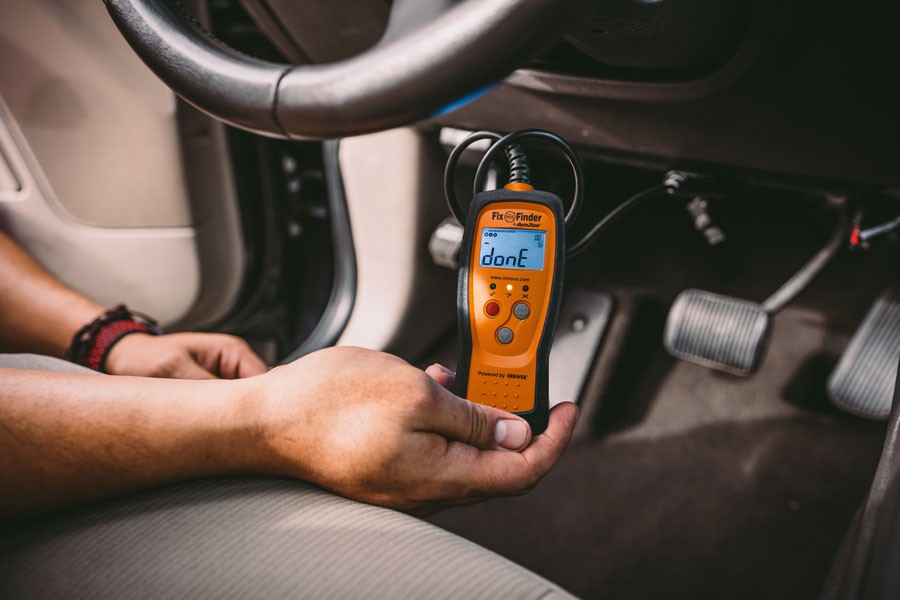Knowing where to plug in your car diagnostic scanner, also known as an OBD2 scanner or code reader, is the first step to understanding your vehicle’s health. Whether your check engine light has illuminated or you’re proactively monitoring your car’s performance, the On-Board Diagnostics II (OBD2) port is your gateway to valuable information. This article will guide you directly to the location of this crucial port and explain how to connect your scanner, empowering you to take control of your car maintenance.
Locating Your OBD2 Port: The Diagnostic Gateway
For almost every passenger car and light truck manufactured since 1996 in the United States (and similar timeframes globally), the OBD2 port location is standardized for easy access. You’ll typically find this essential connector nestled underneath the dashboard on the driver’s side.
Specifically, you should look for a 16-pin, female connector that has a distinctive trapezoidal shape. It’s often located within easy reach, not requiring any tools or significant contortion to access. In most vehicles, it’s positioned in the area below the steering wheel and above the pedals. You might need to crouch down and look upwards to spot it.
While the driver’s side under the dash is the most common location, there are a few exceptions. In some vehicle models, the OBD2 port might be:
- Within the center console: Occasionally, manufacturers place the port inside the center console, often under a small cover.
- Under the passenger side dashboard: Less frequently, you might find it on the passenger side, in a similar position to the driver’s side.
If you’re having trouble locating it, consult your vehicle’s owner’s manual. The manual will usually indicate the exact location of the OBD2 port within your specific model. You can also use your phone’s flashlight or a portable light to illuminate the area under the dashboard for better visibility.
Once you’ve located the OBD2 port, take a moment to visually confirm its trapezoidal shape and the 16 pin slots. This will ensure you’ve found the correct connector before attempting to plug in your diagnostic scanner.
Step-by-Step Guide: Connecting Your Car Diagnostic Scanner
Connecting your OBD2 scanner is a straightforward process. Follow these steps to establish a secure connection and begin diagnosing your vehicle:
-
Turn Off the Ignition: Ensure your vehicle’s ignition is completely turned off. This is a safety precaution and ensures proper communication between the scanner and your car’s computer. Remove the keys from the ignition to be certain.
-
Connect the OBD2 Scanner: Take the male connector of your OBD2 scanner and carefully align it with the female OBD2 port in your car. The trapezoidal shape ensures it will only fit in one orientation. Gently push the scanner’s connector into the port. You might feel a slight resistance, but it should connect smoothly with a firm, but not forceful, push. A slight wiggle can sometimes help ensure a full connection.
-
Turn the Ignition to the “ON” Position (Engine Off): Insert your key into the ignition and turn it to the “ON” position. This position powers up your car’s electrical systems and computer, but do not start the engine. This step provides power to the OBD2 port and allows the scanner to communicate with your vehicle’s modules.
-
Wait for the Scanner to Power Up: In most cases, the OBD2 port itself provides power to your diagnostic scanner. Once connected and the ignition is in the “ON” position, your scanner should automatically power up. Wait for it to complete its boot sequence. This may take a few seconds, and the scanner’s screen will usually indicate when it’s ready.
-
Follow Scanner Prompts: Once your scanner has booted up, it will typically guide you through any further steps or information it requires. This could include:
- Vehicle Information: Some scanners may ask for your vehicle’s Vehicle Identification Number (VIN), engine size, or year, make, and model.
- Engine Start Instruction: Depending on the type of diagnostic test you want to perform, the scanner might prompt you to start the engine. Follow these on-screen instructions carefully.
With these simple steps, you’ve successfully connected your car diagnostic scanner and are ready to delve into understanding your vehicle’s condition.
Navigating the OBD2 Scanner Menu: Unlocking Vehicle Data
Once your scanner is connected and powered on, you’ll be greeted by a menu offering various diagnostic options. The specific menu items will depend on the capabilities of your OBD2 scanner, ranging from basic code readers to advanced professional-grade tools. Commonly, you’ll find options such as:
-
Read Codes: This is the primary function for diagnosing issues. Selecting “Read Codes” will instruct the scanner to retrieve any Diagnostic Trouble Codes (DTCs) stored in your vehicle’s computer modules. These codes are numerical identifiers for specific faults. The scanner may also provide a brief description of the problem associated with each code. If multiple codes are present, the scanner will typically scroll through them.
-
Erase Codes: After you’ve addressed the issue indicated by a DTC, you can use the “Erase Codes” function to clear the codes from your car’s computer memory. Be cautious when using this function, as it will clear all stored diagnostic information. Typically, the scanner will ask for confirmation before erasing codes to prevent accidental clearing.
-
Live Data (or Data Stream): More advanced scanners offer a “Live Data” or “Data Stream” function. This powerful feature allows you to monitor real-time sensor readings from various systems in your vehicle. You can observe parameters like engine temperature, RPM, oxygen sensor readings, and much more as they change. This is invaluable for diagnosing intermittent issues or monitoring system performance.
-
Freeze Frame: “Freeze Frame” data captures a snapshot of sensor values at the exact moment a DTC was triggered. This provides valuable context and clues about the conditions that were present when the fault occurred, aiding in diagnosis.
-
Vehicle Info (or VIN): This menu option typically displays information about your vehicle’s build, often retrieved directly from the VIN stored in the car’s computer.
-
I/M Readiness (Inspection/Maintenance Readiness): This section is particularly useful for emissions testing. It checks the status of various emissions-related systems and indicates whether your vehicle is ready for a smog check. It can highlight potential issues that might cause you to fail an emissions test.
Most OBD2 scanners are equipped with buttons for navigation. Arrow buttons allow you to scroll through menu options, a select or “OK” button confirms your choice, and a “back” or “escape” button lets you return to the previous menu. Even Bluetooth or Wi-Fi scanners controlled via smartphone apps will have intuitive interfaces for navigating these functions.
Decoding Car Diagnostic Codes: Understanding DTCs
When you use the “Read Codes” function, your scanner will display codes that need interpretation. These Diagnostic Trouble Codes (DTCs) follow a standardized format: a letter followed by four numbers, such as P0301.
The initial letter indicates the vehicle system where the fault originated:
- P (Powertrain): Relates to the engine, transmission, fuel system, and emissions control systems. This is the most common category.
- B (Body): Indicates issues within body control systems, including airbags, power windows, interior lighting, and other comfort and convenience features.
- C (Chassis): Points to problems in chassis systems like the anti-lock braking system (ABS), traction control, suspension, and power steering.
- U (Network/Communication): Signifies network communication issues between different computer modules in the vehicle.
The first number following the letter is either a “0” or a “1”.
- 0: Indicates a generic code. These codes are standardized across all vehicle manufacturers, meaning a P0301 code will have the same general meaning regardless of the car brand.
- 1: Signifies a manufacturer-specific code. These codes are defined by the individual car manufacturer and may have more specific meanings related to that brand’s systems.
The subsequent digits provide further details about the specific system and fault. For example, the third digit in a “P” code can indicate:
- 1 & 2: Fuel and air metering issues.
- 3: Ignition system or misfire problems.
- 4: Auxiliary emission controls.
- 5: Vehicle speed control or idle control system faults.
- 7, 8, & 9: Transmission-related codes.
- A, B, & C: Hybrid-specific codes.
The final two digits narrow down the fault even further, leading to hundreds of possible combinations and detailed descriptions.
Using our example code, P0301, we can decipher it as follows: “P” indicates a Powertrain code, “0” means it’s a generic code, and “3” points to an ignition system or misfire. Specifically, P0301 translates to “Cylinder 1 Misfire Detected.”
Understanding this DTC structure empowers you to begin diagnosing the root cause of vehicle problems effectively.
Saving Money with Car Diagnostic Scanners
Investing in a car diagnostic scanner can lead to significant savings in auto repair costs in several ways:
-
Early Problem Identification: When your check engine light illuminates or you notice performance issues, a quick scan can provide initial clues about the potential source of the problem. While it may not pinpoint the exact cause, it gives you a starting point for diagnosis, potentially saving you from expensive guesswork at a repair shop.
-
Smog Check Readiness: Before heading to a smog check, you can use the I/M Readiness test on your scanner to verify if your vehicle is likely to pass. Identifying and addressing potential issues beforehand can prevent costly re-tests and repairs needed to pass emissions inspections.
-
DIY Diagnostics and Repairs: For many common issues, an OBD2 scanner can empower you to perform DIY diagnostics and even repairs. For example, a code like P0138 indicating a high voltage issue with an oxygen sensor can often be resolved by simply replacing the sensor yourself. By scanning and clearing codes yourself after a repair, you can save on both diagnostic fees and labor costs at a mechanic.
Consider purchasing your own OBD2 scanner to take control of your car maintenance and potentially save money on repairs. Auto parts stores like AutoZone also offer loan-a-tool programs where you can borrow scanners for free, making diagnostics even more accessible.
FAQ: Common Questions About OBD2 Scanners
How do you use an OBD II scanner?
Plug the scanner’s connector into the OBD2 port under your dashboard, turn the ignition to the “ON” position (engine off), and follow the on-screen prompts to read codes or perform other diagnostic functions.
Does the car have to be running to use an OBD2 scanner?
No, in most cases, you can read trouble codes with the ignition in the “ON” position without the engine running. The OBD2 port receives power in the “ON” position.
How do I read my OBD scanner results?
Select “Read Codes” on your scanner’s menu. Note down the displayed DTCs (Diagnostic Trouble Codes). The letter and numbers in the code provide information about the affected system and the nature of the fault. Consult a DTC code database or repair manual for detailed descriptions of each code.
Can you plug in an OBD scanner while the car is running?
While technically possible, it’s generally not recommended to plug in or unplug an OBD2 scanner while the engine is running. It’s best practice to turn the ignition off before connecting or disconnecting the scanner to ensure safe and reliable operation. If you need to initiate a test while the engine is running, follow your scanner’s specific instructions.


